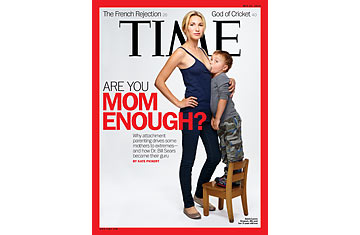
Joanne Beauregard is nothing so much as she is a mother. When she and her husband had trouble conceiving, Joanne quit her job as an accountant to focus full time on getting pregnant. When she did, she chose to give birth at home, without pain medication. Then, for months, Beauregard sat on the couch in her Denver-area living room, nursing her infant from sunup to sundown. She nursed much of the night as well, since the baby slept in bed with Beauregard and her husband Daniel, a software engineer.
When Beauregard got pregnant with her second child, she continued breast-feeding her daughter. This led to a hormonal release that caused contractions and nearly sent her into premature labor. But Beauregard persevered, and the second baby, born March 2, now breast-feeds alongside his big sister, who's nearly 2.
Joanne and Daniel, who've been married since 2004 and "did the yuppie thing for years," according to Joanne, ended much of their social life when they became parents. There are no date nights. Joanne doesn't get away for afternoons to have lunch with her girlfriends. In fact, the only time Joanne has ever left either of her children in anyone else's care was when she was in labor with her second child.
"Going into this, I never would have thought we would parent the way we do," she says. "I thought other parents who did this were crazy."
A lot of people might use the same word to describe the child-rearing philosophy Joanne subscribes to. It's called attachment parenting, and its rise over the past two decades has helped redefine the modern relationship between mother and baby. It's not just staunch devotees like Joanne; the prevalence of this philosophy has shifted mainstream American parenting toward a style that's more about parental devotion and sacrifice than about raising self-sufficient kids.
If you've had a baby in the 21st century, chances are good that you've encountered The Baby Book, the 767-page tome responsible for popularizing attachment parenting. First published in 1992, The Baby Book is now in print in 18 languages, with more than 1.5 million copies sold. Chances are also good that, consciously or not, you've practiced some derivative of attachment parenting or been influenced by its message that mothers and babies evolved to be close to each other.
While the concept sounds simple, the practicalities of attachment parenting ask a great deal of mothers. The three basic tenets are breast-feeding (sometimes into toddlerhood), co-sleeping (inviting babies into the parental bed or pulling a bassinet alongside it) and "baby wearing," in which infants are literally attached to their mothers via slings. Attachment-parenting dogma also says that every baby's whimper is a plea for help and that no infant should ever be left to cry.
This demanding brand of child rearing has ignited a philosophical battle that rages within the parenting community. At least two books refuting the principles of attachment parenting have already been published this year, on the heels of 2011's blockbuster Battle Hymn of the Tiger Mother, a book about why parents should demand more from their children and not the other way around. In a way, the arguments for and against attachment parenting mirror questions about family and work that still divide America five decades after the advent of modern feminism, when nearly half the U.S. workforce is made up of women. Ann Romney, wife of the presumptive Republican nominee for President, became known to many voters because of an attack she recently endured for being a stay-at-home mom.
Attachment parenting says that the more time babies spend in their mothers' arms, the better the chances they will turn out to be well-adjusted children. It's not a big leap from there to an inference that can send anxious moms into guilt-induced panic: that any time away from their baby will have lifelong negative consequences. The debate and the anxiety have become a self-perpetuating cycle. So is attachment parenting a misogynist plot to take women out of the workplace and put them back in the home full time? Or is it a way to encourage mothers and babies to form loving bonds, which science has shown is beneficial to long-term emotional health and well-being?
To answer these questions, it seems appropriate to ask the person who wrote the attachment-parenting bible, The Baby Book, which turns 20 this year. For all the book's popularity and influence, surprisingly little is known about its author, Dr. William Sears, even though he has appeared on countless television shows, wrote a now defunct but long-running column in Parenting magazine and has written, with his wife, a whole library of parenting literature.
It turns out that many of Sears' views are less extreme than his critics (and even many of his followers) realize. And attachment parenting is rooted just as much in Sears' childhood as in his experience as a pediatrician. The origins for The Baby Book, in fact, can be found in 1950s St. Louis and deep in the Venezuelan jungle.
